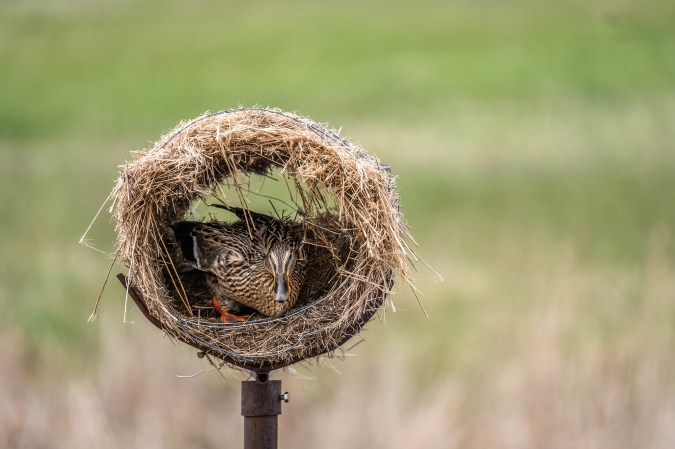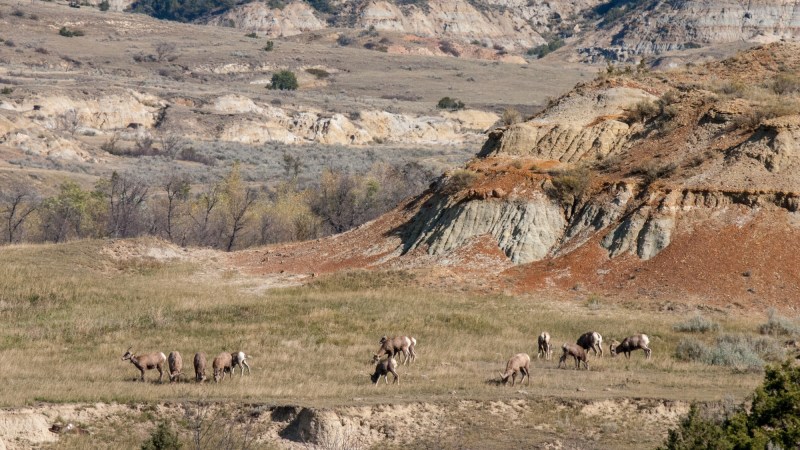An announcement from the North Dakota Game and Fish Department included some good news for waterfowlers in the Central Flyway on Thursday. During the annual midwinter waterfowl survey this month NDGFD biologists counted a record high number of Canada geese in the state. Their final tally was more than 300,000 geese, up from a previous record of around 220,000. Biologists also counted a higher-than-average number of snow geese and mallards. And thanks to the cold snap that came on the heels of the survey, waterfowlers farther south who still have open seasons should be seeing some of these birds headed their way (if they aren’t there already).
NDGFD migratory game bird management supervisor Mike Szymanski explains that biologists do most of their survey work along the the Missouri River system using small, fixed-wing aircraft. They also look at other areas around the state and count birds on foot, but Szymanski says more than 95 percent of the Canada geese they counted were along the Missouri River system — particularly on Lakes Oahe and Sakakawea.
Every state agency in the Lower 48 participates in the survey as well, and they conduct this work at the same time — during the first week of January — to reduce the chances of counting the same birds more than once. The data from these surveys gives biologists a more complete understanding of overall populations, especially for arctic-nesting geese and other birds that don’t get counted during the larger annual breeding survey the U.S. Fish and Wildlife Service conducts in the spring. Szymanski and Jake Hewitt, a waterfowl biologist with NDGFD, tell Outdoor Life that it will be some time until the data from all these states can be looked at together, so they can’t yet speak to the number of birds counted in other states. Likewise, it will be a while until biologists can determine what these numbers may indicate for the next breeding season.

“It’s also useful information just to know where birds are distributed this time of year,” Hewitt says. “That can help with how states want to set seasons, or just for hunters to know when and where to expect the birds to be. Of course, with a changing climate, we can expect to see potential shifts in distribution, and changes in the habitat on the landscape can certainly have an influence. So, it helps us keep track of all that.”
As for why biologists counted so many geese in early January, their primary explanation won’t come as a surprise to waterfowlers across the country — many of whom experienced lower success rates during the early season due to unseasonably warm weather. Conditions were especially warm and dry during December, when temperatures in North Dakota were almost 10 degrees above average for the entire month.
“Those really warm temperatures meant there was hardly any ice on the [Missouri] River, so [the birds] weren’t limited by the amount of places they could roost,” Hewitt says. “There also wasn’t very much snow on the landscape in December, so they had a lot of feeding opportunities. There’s no real reason for them to leave the state when it’s that warm.”
On top of record-high Canada geese numbers, Szymanski, Hewitt, and the other biologists were surprised by the amount of snow geese and mallards they found. Most years they see zero snow geese, and this January they counted around 9,000. They also counted upwards of 43,000 mallards, which is a sizable jump from the average of 5,000 to 10,000 seen in past winters. Szymanski also helped break down the kinds of birds they counted during the survey.
“The bulk of our record numbers this year were made up of [honkers]. Roughly 40,000 of the Canadas were small geese that hunters typically see in Oklahoma and Texas, while the honkers that we counted in early January are geese that often winter in central South Dakota and Nebraska,” Szymanski explains. “The last of the waterfowl that would have been more likely to winter in the Mississippi Flyway would have departed the state by mid-December when the last of open water in the pothole region of the state froze up. However, most of those birds were blown out by a late-October blizzard.”
Soon after the survey was completed, the northern Plains and other regions across the country experienced a major cold front that brought subzero temperatures and snow. This certainly got some of those birds moving, but Szymanksi says it might be a little too late in the season for hunters further south in the Central Flyway to expect huge pushes of honkers.
“With it being this late in the year, and we still don’t have meaningful snow cover, most of the big Canada geese wouldn’t have left on account of our cold snap,” says Szymanski, who worked on a recent telemetry study that found mallard migrations in the region tend to decrease after or around the winter solstice, even when cold fronts pass through. “The little Canadas probably would have left along with [some of] the mallards. But as it gets later in winter, the birds are just less likely to migrate.”
Read Next: The Smartest Ways to Trick Late-Season Canada Geese When You Can’t Get on the X
Still, the recent change in weather brings some hope to waterfowl hunters farther south in the Central Flyway where some goose and duck seasons remain open. And the record-high survey numbers seen in North Dakota can help give us a better understanding of when we can expect pushes of birds in the future.
“This could be something for hunters to be thinking about as they put the pieces together,” Hewitt says.

















